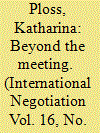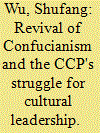|
|
|
Sort Order |
|
|
|
Items / Page
|
|
|
|
|
|
|
| Srl | Item |
| 1 |
ID:
105189


|
|
|
|
|
| Publication |
2011.
|
| Summary/Abstract |
Intercommunity dialogue encounters are a crucial tool for constructive conflict resolution. This research examines grassroots dialogue encounters with regard to the societal position of the participants, as well the situation `on the ground' as influential to the transfer process. Interviews in Northern Ireland and Kosovo with community activists stressed the effectiveness of personal characteristics of dialogue participants when it came to transfer. Moreover, the readiness - affected by socio-economic conditions as well as external/secondary conflict parties - of the peer group to listen to its participant seemed fundamental.
|
|
|
|
|
|
|
|
|
|
|
|
|
|
|
|
| 2 |
ID:
181562


|
|
|
|
|
| Summary/Abstract |
Legislators often rely on cues from colleagues to inform their actions. Several studies identify the boardinghouse effect, cue-taking among U.S. legislators who lived together in the nineteenth century. Nevertheless, there remains reason for skepticism, as legislators likely selected residences for reasons including political similarity. We analyze U.S. House members’ residences from 1801 to 1861, decades more than previously studied, and show not only that legislators tended to live with similar colleagues but also that coresidents with divergent politics were more likely to move apart. Therefore, we deploy improved identification strategies. First, using weighting, we estimate that coresidence increased voting agreement, but at only half of previously reported levels. Consistent with theoretical expectations, we find larger effects for weaker ties and those involving new members. Second, we study legislators who died in office, estimating that deaths increased ideological distance between survivors and deceased coresidents.
|
|
|
|
|
|
|
|
|
|
|
|
|
|
|
|
| 3 |
ID:
080991


|
|
|
|
|
| Publication |
Hampshire, Ashgate Publishing Limited, 2007.
|
| Description |
ix, 249p.
|
| Standard Number |
9780754648185
|
|
|
|
|
|
|
|
|
|
|
|
Copies: C:1/I:0,R:0,Q:0
Circulation
| Accession# | Call# | Current Location | Status | Policy | Location |
| 053427 | 306.201/PRI 053427 | Main | On Shelf | General | |
|
|
|
|
| 4 |
ID:
131795


|
|
|
|
|
| Publication |
2014.
|
| Summary/Abstract |
Increasing participation in decision-making processes by service users is one of the objectives of decentralisation reforms in Tanzania. The argument is that decentralisation enhances participation by all sections of the community, and by women in particular, and results in decisions that better reflect local needs. This paper examines the impact of decentralisation reforms on service users' participation for delivery of water and health services in rural Tanzania, using a gender perspective and principal-agent theory. The paper investigates how decentralisation has fostered spaces for participation and how men and women use these spaces, and identifies factors that constrain or encourage women's participation. It shows that decentralisation reforms have created spaces for service users' participation at the local level. Participation in these spaces, however, differs between men and women, and is influenced by the socio-cultural norms within the household and community. Men have gained more leverage than women to exercise their agency as principals. Women's participation is contributing to addressing practical gender needs, but strategic gender needs have been less adequately addressed because gendered power relations have been largely untouched by the reforms.
|
|
|
|
|
|
|
|
|
|
|
|
|
|
|
|
| 5 |
ID:
109935


|
|
|
|
|
| Publication |
2011.
|
| Summary/Abstract |
How can minority cultures resist assimilation into a global monolith in an increasingly "small world"? Paradoxically, Axelrod found that local convergence can actually preserve global diversity if cultural influence is combined with homophily, the principle that "likes attract." However, follow-up studies showed that this diversity collapses under random cultural perturbation. The authors discovered a new source of this fragility-the assumption in Axelrod's model that cultural influence is interpersonal (dyadic). The authors replicated previous models but with the more empirically plausible assumption that influence is social-people can be simultaneously influenced by several network neighbors. Computational experiments show that cultural diversity then becomes much more robust than in Axelrod's original model or in published variations that included either social influence or homophily but not both. The authors conclude that global diversity may be sustained not by cultural experimentation and innovation but by the ability of cultural groups to discourage those activities.
|
|
|
|
|
|
|
|
|
|
|
|
|
|
|
|
| 6 |
ID:
133818


|
|
|
|
|
| Publication |
2014.
|
| Summary/Abstract |
The revival of Confucianism in the first decade of the twenty-first century is a political phenomenon that cannot be ignored with regard to its social influence and the particular meaning it has brought to China. However, so far, there has not been much academic research into the political reasons for this revival at a deeper level. Based on the 228 articles published in the People's Daily in the years between 2000 and 2009, a content analysis is conducted on how Confucianism was represented in this authoritative official medium. The examination of the role that Confucianism plays in the construction of the socialist 'advanced culture' provides a clear lens to observe the role of Confucianism in the Chinese political ideology, which is still rooted and based on Marxism-Leninism. This research is aimed at clarifying how Confucianism was pragmatically promoted by the government of the Chinese Communist Party (CCP) with the purpose of securing its cultural leadership. This state-led promotion reveals the vulnerability of the political status of Confucianism in contemporary China and its unsecured future.
|
|
|
|
|
|
|
|
|
|
|
|
|
|
|
|
| 7 |
ID:
133935


|
|
|
|
|
| Publication |
2014.
|
| Summary/Abstract |
This paper shows how UN Security Council resolutions can facilitate the international socialization of an Islamist political actor. The study undertakes a process-tracing analysis of the negotiations and attempts to implement UNSC Resolutions 1559 and 1701 and then assesses their impact on Hezbollah's agency and political identity. The author argues that UNSC resolutions can inform processes of social influence that directly affect the activity of non-state actors and then cause international socialization. According to the analysis proposed international socialization has produced three main effects on Hezbollah that are: increased accountability; a shift in its legitimacy paradigm; and a mutation of Hezbollah's relation with the Lebanese state.
|
|
|
|
|
|
|
|
|
|
|
|
|
|
|
|
| 8 |
ID:
122898


|
|
|
|
|
| Publication |
2013.
|
| Summary/Abstract |
In episodes of intergroup violence, which group members participate and which do not? Although such violence is frequently framed as occurring between distinct ethnic, racial or sectarian groups, it is easily overlooked that it is usually only a subset of the group's members who in fact participate in the violence. In predicting participation, extant research has privileged an atomistic approach and identified individual attributes indicative of a predisposition to violence. I suggest instead that a situational approach should complement the atomistic paradigm and present evidence that an individual's micro-spatial environment is an important predictor of differential participation in intergroup violence. Using GIS data on 3,426 residents from one community, I map the household locations of participants, non-participants, and victims of Rwanda's 1994 genocide. I find that participants are likely to live either in the same neighbourhood or in the same household as other participants. Specifically, as the number of violent to nonviolent individuals in an individual's neighbourhood or household increases, the likelihood of this individual's participation also increases. In explaining these neighbourhood and household effects, I suggest social influence is the mechanism at work. As micro-spatial distance decreases, micro-social interaction increases. Neighbours and household members exert influence for and against participation. Participation then may be as much the product of social interaction as of individual agency. What neighbours and family members think, say and do may influence participation in collective action such as intergroup violence. The conceptualization of neighbourhoods and households as micro-spheres of influences suggests the importance of social structure as a determinant of participation.
|
|
|
|
|
|
|
|
|
|
|
|
|
|
|
|
|
|
|
|
|